A filterless, or Non-System, Brigham pipe is a rare bird, indeed. The Toronto-based manufacturer sold non-system pipes alongside their patented Brigham System pipes featuring the Rock Maple Distillator from the late 1930s until the mid-1950s. By that time the vast majority of Brigham pipes sold were system pipes, so the non-filtered versions were quietly retired.
Filterless Brigham pipes were briefly reintroduced in the late 1990s and early 2000s as Brigham sought to gain a foothold in the US, a market which was considered to be “anti-filter”. Given the choice, however, most American pipe smokers purchases a pipe fitted with the Brigham System, and thus the non-system Brigham disappeared again well before the product line was updated in 2007.
It was with some interest, therefore, that I anticipated the arrival in the shop of an unfiltered Brigham pipe from the latter production period. This Brigham 530, which I’ll describe as a 1/8th-Bent Brandy, had suffered an unfortunate fall, leaving the bottom of the bowl peppered with dents – a good case of “road rash”, if you will.
This series of pics shows the pipe as it looked on arrival. In addition to the patch of dents on the bowl, the rim had some carbon buildup and the stem carried a small amount of tooth chatter at the button.
Digging into my notes for the Brigham Book project (yes, it’s still in the works, though COVID has made a mockery f my original timeline), I am reminded that
During the Transition Era (roughly 2001-2006), the 100 – 300 series pipes looked very similar to Canadian-made pipes and continued to be recognized by their traditional brass pin patterns. These lower series pipes were offered in 9 shapes. The 400 series disappeared temporarily, while the 500 to 700 series pipes, available in only 8 shapes, lost their brass pins and were identified only by their 3-digit shape numbers.
500 series pipes were fully or partially rusticated, the 600 series featured a larger proportion of smooth finish, and the 700 series were fully smooth, made from near-flawless briar without fills or rustication. 500-700 series pipes from this period were fitted with a silver (nickel?) band with the Brigham leaf logo and a choice of acrylic stem in either black or green marble.
This Brigham 530 has the nickel cuff with the “B in Maple Leaf” logo and a rather nice looking black acrylic stem. The 3-digit shape number is stamped on the underside of the bowl.
Where things get a bit more interesting to the collector is that instead of being stamped simply “Brigham”, the left shank is stamped “Brigham” over “Made in Canada” – a stamp primarily used in the 1970s. This would seem to indicate the use of New Old Stock stummels for at least some Transition Era pipes.
Getting on with the initial cleaning of the pipe, I used a half dozen or so pipe cleaners and a shank brush dipped in isopropyl alcohol to clean the airway through the stem. I was a bit surprised when the first pipe cleaner came out very dark – given the overall clean state of the exterior of the pipe, I had rather expected to find less tarts lurking within. Correcting the situation was, however, easy enough.
I reamed a fairly light, but soft and slightly sticky cake from the chamber and tidied things up with sandpaper wrapped around a dowel. The thin layer of carbon on the rim surrendered easily to a few cotton swabbed wetted with good old saliva, and some 0000 steel wool removed the residue.
I then got stuck in cleaning the stummel’s shank and airway. Again armed with a shank brush, alcohol and a handful of cotton swabs, I cleared out a modest amount of tarry buildup from the pipe’s internals.
I don’t always do an alcohol treatment on a pipe sent for exterior work, but I thought on this occasion it might be a prudent move. Before closing up for the night, I stuffed some cotton wool into the shank and filled the bowl with kosher salt. Topping up the bowl with more isopropyl alcohol, I left the stummel overnight to give the alcohol time to dissolve any residual tars.
When I came back to the pipe the next morning, the salt and cotton had turned various shades of caramel to dark brown, which vindicated my decision to perform the deep cleaning. I dumped out the spent salt, removed the cotton and let the pipe air for a few minutes so any leftover alcohol could evaporate.
Then it was time to deal with the dents in the bottom of the stummel. It was hard to juggle all the required parts, so pictures are rather scanty here. I usually reach for an electric soldering iron as a heat source for steaming out dents, but the affected area was fairly small so I elected to go old-school and heat the blade of my pen knife over a candle.
The process here is straightforward. I dipped the edge of a cotton pad in some clean water, then positioned the wet pad over the dents before applying the hot knife blade to create steam. The steam pentanes the wood fibers, causing them to swell back to, or very close to, their original position.
Here is a reminder of what the damaged area looked like before the work. The dents weren’t terribly deep but they certainly detracted from the smooth finish and the lovely briar grain.
And this pic shows the same area from a different angle after the dents had been steamed out and the area lightly sanded. Much better!
A quick minute with a stain pen blended the repair into the original finish. My scribbling is a bit visible in the pic below, but buffing on the wheel will smooth things out.
Before taking the pipe to the wheel, however, I needed to give the stem a little love. A scrap of 1000-grit sandpaper sorted out the tooth chatter. I followed up with a light sanding with 2000-grit paper, then gave the bowl and stem a run on both the Red Tripoli and White Diamond wheels followed by a few light coats of Carnauba wax to shine and protect the repaired pipe.
The finished pipe is clean, fresh and looking good, without the former distractions which reduced the impact of the gorgeous flame grain on this stummel. Set off by the glossy black acrylic stem and the silver shine of the shank band, this 20-year-old Brigham 530 is dressed to impress and is now once again in the hands of its steward, who is happy to have a favourite pipe back in his rotation.
Thanks for joining me for this estate pipe restoration project. It’s been a while since I last steamed out a patch of road rash; I hope you find the technique a valuable addition to your own restoration toolbox.
Until next time, Happy Piping! Here’s the finished pipe.



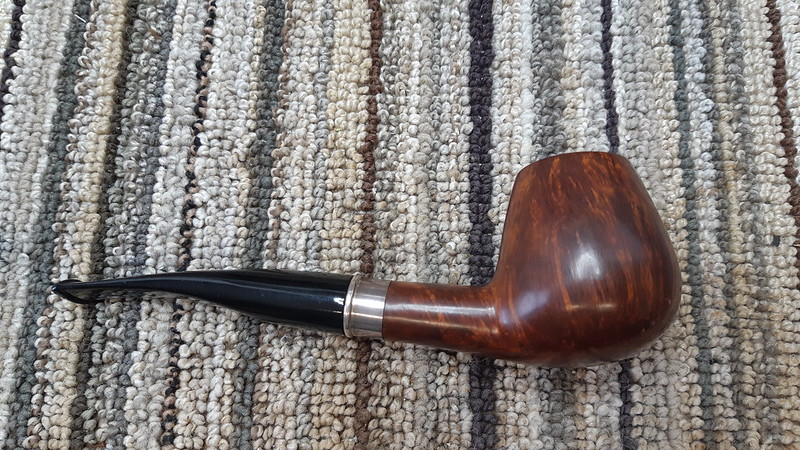



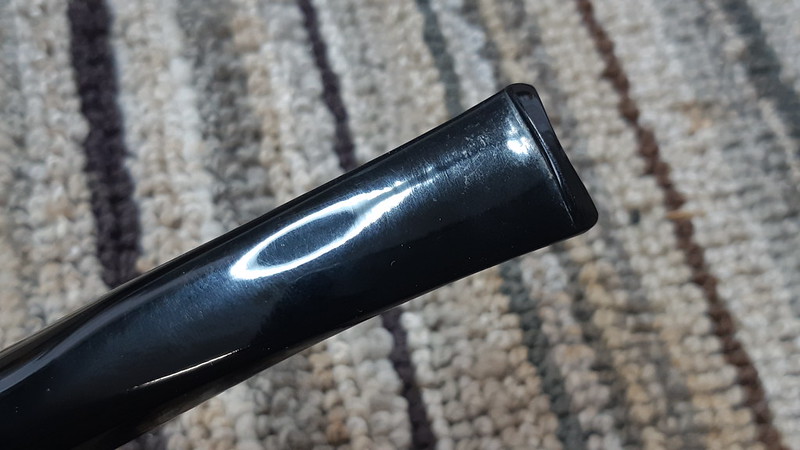







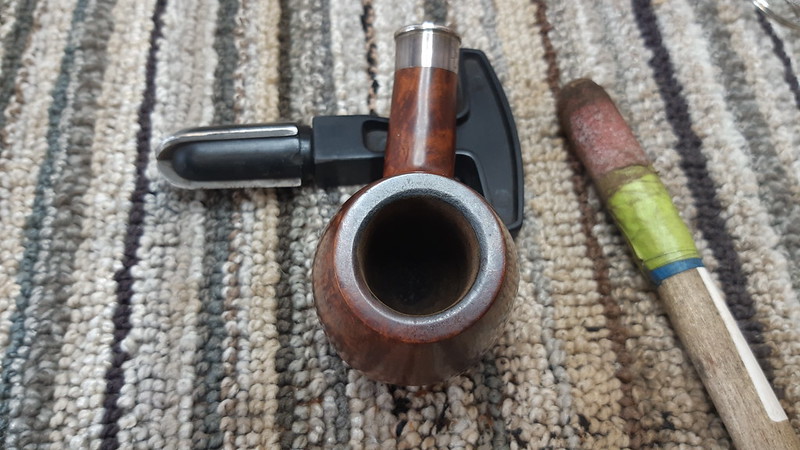




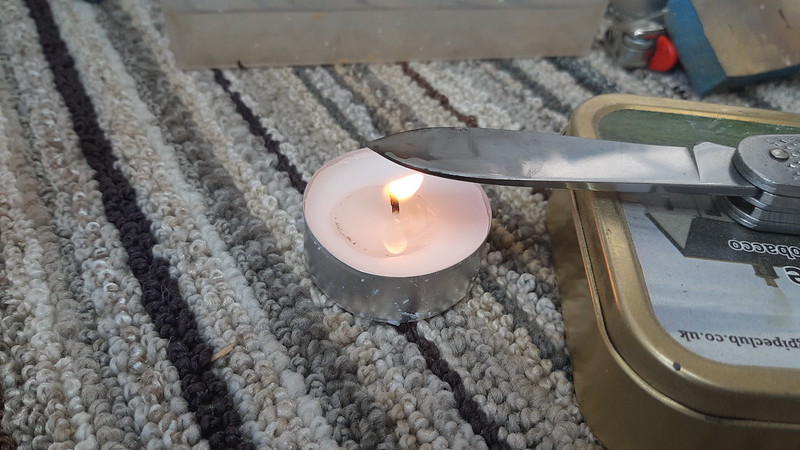
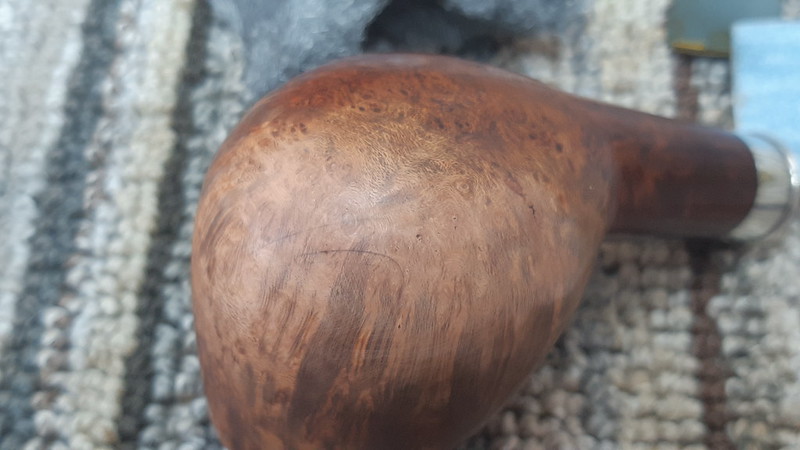













Glad to hear the book is still hapening.
LikeLiked by 2 people
It was stalled out for a while during lockdown/stay at home orders, but I’m working on some additional material in between pipe repairs. Slow going but it’s going! 😁
LikeLiked by 1 person
Charles, a belated reply. I’ve read this one twice. Thanks for sharing your work with all of us in the hobby–it’s really appreciated. Glad to hear the Brigham book is still in the works. And happy fishing!! Catch one for me.
LikeLiked by 2 people
Thanks, Mark!
LikeLiked by 1 person